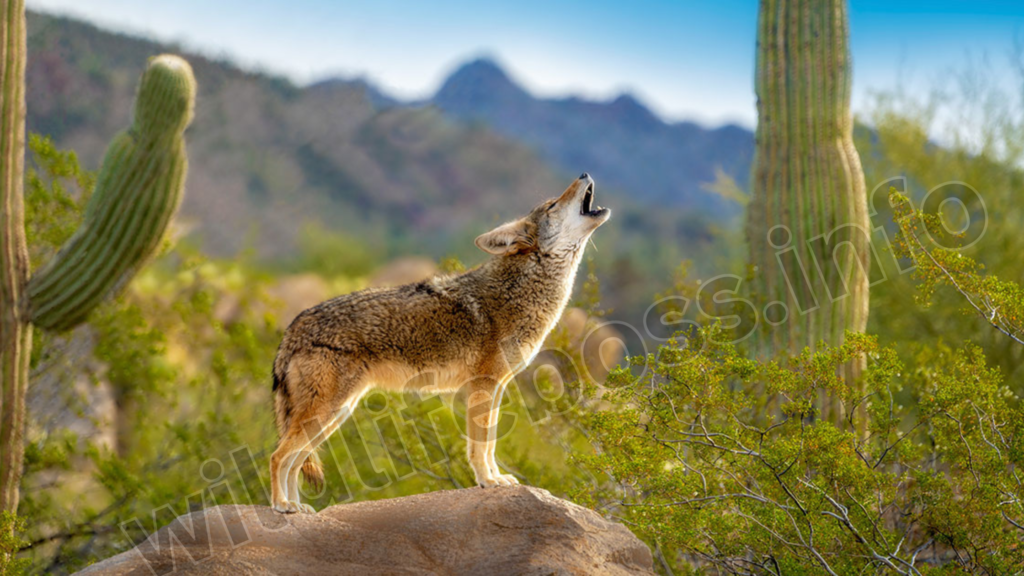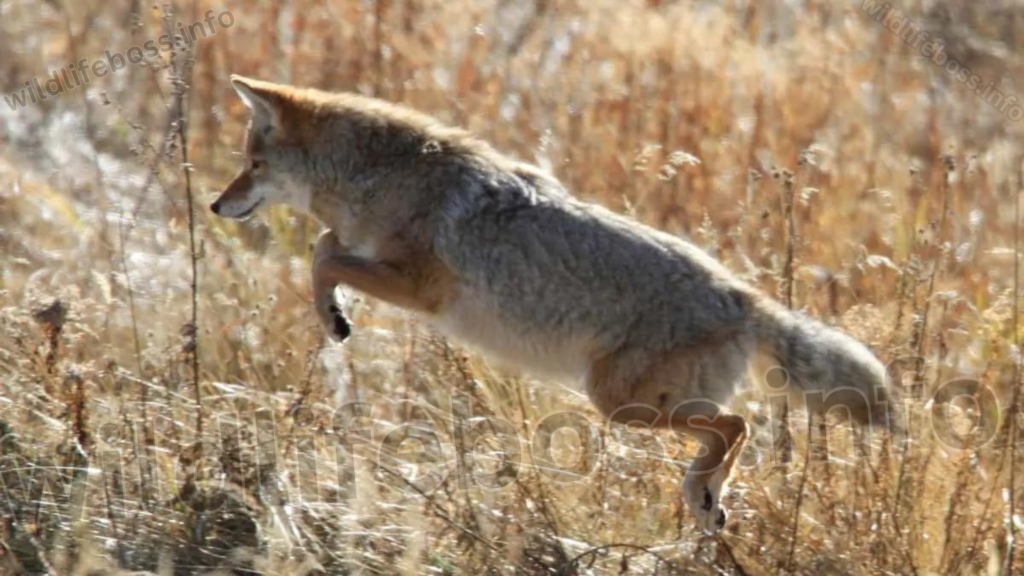One of the most common species of wild canines in North and Central America are coyotes.
Their skulls resemble those of every other member of the Canidae family, and they have traits in common with both domestic dogs and wolves. Strong, pointed teeth are part of coyote.
The upper jaw of an adult coyote has 42 teeth and a dental formula of 3.1.4.2. This indicates that on each side of the maxilla, they have two molars, four premolars, one canine, and three incisor teeth. For the bottom teeth, the dental formula is 3.1.4.3.The majority of coyote teeth get their permanent teeth about five months of age, and their canines measure around 1.45 inches in length.
* A brief summary of coyote teeth information is provided in the table below:
| Hemimaxilla dental formula (I.C.PM.M) | 3.1.4.2 |
| Hemijaw dental formula (I.C.PM.M) | 3.1.4.3 or 3.1.4.4 |
| Total number of teeth | 42 to 44 |
| Canine teeth length | 1.45 inches |
| Milk teeth eruption | Approx. 2 weeks |
| Permanent dentition eruption | 4 to 5 months |
| Bite force | 727 PSI |
*Research papers, scientific journals, and other official sources listed throughout the text provided the data in the above table.
Coyote Jaw Morphology And Dental Formula
Members of the Canidae family include coyotes, scientifically known as Canis latrans. Wolves, foxes, dingoes, and domestic dogs are also members of this family, and they all have a similar dental formula and jaw morphology.
All canids are omnivores, however their primary food source is meat. Thus, the long, thin nose and well-developed jaws are traits of coyotes and other members of the family.
Additionally, the teeth are made to rip into flesh with ease. This trait is crucial for tearing flesh off bones as well as killing animals.
The upper and lower jaws have somewhat distinct dental formulas.
The dental formula for coyotes is 3/3 incisors, 1/1 canines, 4/4 premolars, and 2/2 molars, totaling 20 teeth on the maxilla.
The sole difference is that coyotes have three molars on the lower jaw, which else follows a nearly identical dental formula.
The fourth lower molar, which is thought to be the consequence of individual variation, is present in certain individuals in addition to this extra molar that is unique to all coyotes. It is often smaller in size than the other three molars.
How Many Teeth Do Coyotes Have?

Twenty teeth are located on the upper jaw and twenty-two on the lower jaw of a typical coyote.
However, some coyotes have four teeth in their lower jaw. Instead of 42 teeth, these people have 44.
The fourth molar is found in less than 3% of coyotes, according to studies. Other canid species, such as wolves and foxes, also exhibit the same oddity.
What type of teeth do coyotes have?
The dental structure of coyotes is nearly identical to that of other dogs, whether they are domestic or wild. The incisors, canines, premolars, and molars make up the coyote’s dental anatomy. The coyote’s upper and lower jaws each have four canine teeth that aid in snagging and capturing its prey. You must use your molars or premolars if you need to break apart or crush a large, tough piece of animal flesh. Another name for these is cheek teeth. All other members of the canine family have teeth of this type, but the coyote’s teeth are unique because of its short, narrow, pointed snout and jaws, which enable it to bite fiercely.
Do coyotes have sharp teeth?

The sharp teeth of all members of the Canidae family are well-known. As members of the canine family, coyotes have very sharp and noticeable teeth, but not enough to be compared to a cat’s teeth in terms of sharpness.
Coyotes can easily seize, stab, and rip apart their prey because of their keen teeth. Because of the way the teeth are shaped, they can hold their prey quite tightly. The coyote’s molars and premolars are like blades that can readily smash bones and meat.
Coyote Teeth Size
Coyotes, like the majority of carnivores, have big canine teeth that are used to break bones off of meat and skin.
In particular, the canines of adult coyotes measure between 1.24 and 1.45 inches in length. In comparison to other species, the molars and premolars are likewise rather massive.
The first molar on the lower jaw and the fourth premolar on the upper jaw have a carnassial alteration, which makes them sharper than the other molars and premolars and allows coyotes to shred flesh. This is one of the peculiarities of coyotes’ premolar and molar teeth.
The squarer-shaped premolars and molars that follow are utilized for chewing and smashing food, including bones.
Development of permanent dentition and milk teeth
The dental formula of coyote pups is identical to that of their adult parents. However, pups first develop a pair of milk teeth, just like humans and many other mammals.
By the time a pup celebrates its first month of life, these deciduous teeth will have fully matured as they emerge at around two weeks.
Coyote pups are often weaned at this age and begin consuming solid foods, which are first regurgitated for them by their parents.
Around four to five months of age is when the permanent dentition begins to form, and by the time they are six months old, the majority of puppies will have had their milk teeth replaced by permanent ones. This enables researchers to determine the age of coyote pups based on the type of teeth they have.
Coyote Bite Strength

Coyote teeth and jaws have been created to kill prey and tear flesh, as was previously indicated. However, a strong bite is necessary to kill prey.
Coyotes bite with a medium level of force in comparison to other carnivores. Depending on the source, their biting force quotient ranges from 88 to 94. Coyote teeth were given a bite force quotient of 94 in one study that compared the bite forces of canids. This is roughly the same BFQ as jackals, which fall in between wolves and gray foxes.
Coyotes were given a BFQ of 88 in a different study that compared the bite forces of large biting mammals. Black and brown bears were given lower biting force quotients based on the same study’s calculations of their bite forces.
Coyotes have a bite force of roughly 727 PSI when taking into account the BFQ of the majority of species as well as the fact that body mass is taken into account.
That is actually less than the bite force of grizzly bears and other predators in North America, such as mountain lions, but more than the bite force of lions.
How strong is the coyote’s jaw?
Because of its powerful jaw, coyotes may quickly snare large, hazardous creatures. Although a coyote’s jaw bone may not have as much bite force as a wolf’s (around 400 PSI), it is still powerful enough to tackle moderately sized prey with ease. The jaw measures 4 inches in length and 5.5 inches in width. Because their lower jaw is stronger than their upper jaw, they use it to exert the most force possible.
How much do coyote bites hurt?

Because of its powerful jaw, a coyote’s bite may cause more pain than a determined house cat’s. However, if they bite you more than once, it hurts a lot. You could die if they bite your main blood vessel, though, because blood could spurt from it. We might therefore conclude that a coyote bite can be both painful and extremely lethal.
Can coyote bite go through bone?
It is true that a coyote bite may break your bone. In addition to molars and premolars, they also have carnassial coyote teeth. Your bones may be readily crushed by the force these fangs could provide. When they bite, they first rip apart or break the bones after passing through tiny, delicate tissues.
Can A Coyote Teeth Determine Its Age?

It’s simple to estimate a coyote pup’s age from its teeth, but what about adults? It turns out that a coyote teeth can be used by researchers to estimate its age.
There are several ways to accomplish this, but counting the annuli in the tooth cementum is one of the most widely used techniques.
Since the first ring appears around the time the coyote is 20 months old, this is one of the more dependable methods. Every year after that, a new ring is created.
Even although this technique is precise, it is primarily used to ascertain the age of coyotes that have been killed by other animals or during hunts.
It would be cruel to remove the tooth from a living coyote since the cementum is located closer to the tooth’s core.
Coyote age can be estimated using new, unproven techniques that use tooth wear.
In addition to the reported gum recession in older coyotes, it appears that root thickness and crown length vary with age.
How Are Coyote Teeth Marks Identified?
The dental structure of coyotes is comparable to that of dogs, wolves, and other canids. To determine if an animal was killed by a coyote or another canid, it is essential to accurately identify the bite marks.
Measuring the distance between the tooth marks that the canines left after piercing the skin and flesh is the simplest method of identifying a coyote bite.
Coyote teeth typically cause injuries to the neck area. The punctures are about 1/8 of an inch in diameter, and the distance between the upper canines is typically between 1.125 and 1.375 inches.
Coyote Vs. Wolf Vs. Fox Vs. Dog Teeth
Coyotes, wolves, and red foxes are the most prevalent wild canid species in North and Central America that prey on pets and cattle. Domestic dogs, however, are also capable of killing cats and other small pets, as well as animals and poultry.
You may be wondering how to distinguish between these animals because their jaw forms and dental formulae are similar. As mentioned before determining the distance between the punctures is the simplest method.
The differences in coyote tooth diameter and spacing are shown in the given table:
| Canidae species | Canine teeth spacing | Canine teeth diameter |
|---|---|---|
| Coyote | 1.125 to 1.375 inches | ⅛ inch |
| Wolf | 1.5 to 1.75 inches | ¼ inch |
| Red fox | 0.7 to 1 inch | < ⅛ inch |
| Domestic dog (large to giant breed) | 1.85 to 2.57 | > ¼ inch |
Conclusion:
The teeth of coyotes are comparable to those of other Canidae family members. Each species in this family typically has 42 teeth and the same dental formula.
However, in certain coyotes, a fourth set of molars on the lower jaw can occasionally alter the dental formula and increase the total number of teeth to 44.
In spite of this, you can utilize the size, diameter, and spacing between canines to determine which species is causing problems for your pets or cattle, or which wild dog killed a wild animal.
Read more about coyotes:

